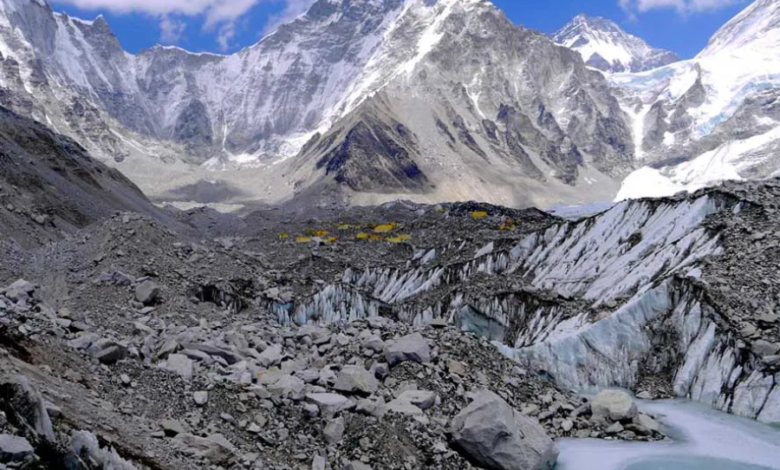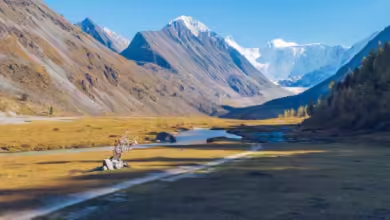Epic Views The Scenery of Everest Base Camp

The scenery of Everest Base Camp is nothing short of breathtaking, offering a visual feast of some of the most awe-inspiring landscapes in the world. As trekkers ascend towards Everest Base Camp, they are treated to an ever-changing panorama that captures the majesty and raw beauty of the Himalayas.
From the outset, the journey reveals a tapestry of diverse environments. The trek begins in lush, verdant forests, where the dense canopy of pine and rhododendron trees gradually opens up to reveal sweeping views of the lower Himalayan foothills. As trekkers climb higher, the landscape transforms dramatically, with the forest giving way to alpine meadows dotted with wildflowers. These meadows provide a colorful contrast to the rugged terrain and set the stage for the grandeur that lies ahead.
Approaching higher altitudes, the scenery becomes increasingly dominated by the formidable peaks of the Himalayas. Everest Trek The first major highlight is the sight of Mount Everest itself, towering above the surrounding peaks. From certain vantage points along the trail, trekkers are treated to an uninterrupted view of Everest’s snow-clad summit, an imposing and humbling sight that captures the essence of the trek. The grandeur of Everest is complemented by other iconic peaks such as Lhotse, Nuptse, and Makalu, each contributing to the dramatic skyline.
The trek also passes through the Khumbu Glacier, a massive expanse of ice and rock that glistens under the sun. The glacier’s crevasses and ice formations add a surreal element to the landscape, making it appear almost otherworldly. The trekker’s journey across the glacier offers a rare opportunity to witness the raw power of glacial formations up close.
As trekkers near Everest Base Camp, the landscape opens up to reveal a sprawling expanse of rocky terrain and vast moraine fields. The base camp itself, nestled at the foot of Everest, provides a panoramic view of the surrounding peaks and valleys, offering a sense of completion and awe. The camp is surrounded by a mix of rugged rock formations and icy slopes, with the imposing Everest providing a constant backdrop.
Throughout the trek, the ever-changing views reflect the dynamic nature of the region’s geology and climate. From the lush green of the lower altitudes to the stark, icy landscapes near the base camp, the scenery of the Everest Base Camp trek is a testament to the natural beauty and grandeur of the Himalayas. The experience of witnessing these epic views firsthand is a profound reminder of the power and majesty of nature, leaving trekkers with lasting memories of an extraordinary journey
Introduction: The Allure of Everest Base Camp
14 Days Trek to Everest Base Camp holds a magnetic allure for adventurers and nature enthusiasts alike, drawing trekkers from around the globe to experience its stunning landscapes and the thrill of standing at the base of the world’s highest peak. The trek to Everest Base Camp is renowned for its breathtaking views, diverse ecosystems, and the profound sense of achievement that accompanies reaching this iconic destination. The journey offers an unparalleled opportunity to witness the majestic grandeur of the Himalayas, where every step reveals new vistas and challenges. From the lush, green valleys to the stark, awe-inspiring terrain near the base camp, the trek is a captivating adventure that intertwines physical challenge with the beauty of one of the world’s most revered mountain ranges. The allure of Everest Base Camp lies not just in its formidable heights but in the transformative experience it offers—immersing trekkers in the rugged splendor of nature and the rich cultural tapestry of the region.
Starting the Journey: Scenic Highlights from Lukla
The trek to Everest Base Camp begins in Lukla, a small mountain town that serves as the gateway to the Himalayas. The flight into Lukla is itself a dramatic experience, offering aerial views of the verdant landscapes and rugged terrain that characterize the region. Once in Lukla, trekkers are immediately struck by the town’s unique charm, nestled high in the mountains with spectacular views of the surrounding peaks. The scenic highlights from Lukla include panoramic vistas of the Dudh Koshi Valley and the towering ridges that frame the town. The initial leg of the trek from Lukla to Phakding is marked by scenic beauty as well, with lush forests and traditional Sherpa villages providing a picturesque start to the adventure. The journey through this verdant landscape offers a gentle introduction to the trek’s more challenging sections, setting the stage for the grander vistas to come.
The Trek Through the Dudh Koshi Valley
The trek through the Dudh Koshi Valley is one of the most enchanting sections of the Everest Base Camp journey. As trekkers follow the meandering trail alongside the river, they are greeted by a landscape of lush greenery and serene river views. The valley is characterized by its dramatic terrain, with steep hillsides and terraced fields that showcase traditional farming practices. The Dudh Koshi River, with its glacial blue waters, adds to the picturesque quality of the trek, creating a soothing soundtrack as it flows alongside the path. The journey through this valley also provides glimpses of the local villages, where traditional Sherpa culture is vividly alive. The natural beauty of the Dudh Koshi Valley, combined with the vibrant cultural scenes, makes this section of the trek a highlight, offering trekkers a perfect blend of scenic and cultural experiences.
Magnificent Views of Thamserku and Kongde Ri
As trekkers advance on their journey to Everest Base Camp, they are treated to magnificent views of Thamserku and Kongde Ri, two prominent peaks that add to the trek’s dramatic scenery. Thamserku, with its distinctive pointed summit, dominates the skyline and offers a stunning backdrop as trekkers make their way through the trails. Kongde Ri, known for its impressive snow-covered heights, complements the scenery with its striking presence. The views of these peaks are especially breathtaking from certain vantage points along the trek, providing a sense of awe and accomplishment. The contrast between the rugged, rocky terrain and the pristine snow-covered peaks creates a visual splendor that enhances the trekking experience. The majesty of Thamserku and Kongde Ri not only adds to the trek’s aesthetic appeal but also symbolizes the grandeur and challenge of the journey towards Everest Base Camp.
The Beauty of Namche Bazaar: The Gateway to the Himalayas
Namche Bazaar, often referred to as the gateway to the Himalayas, is a key highlight of the 12 Days Everest Base Camp trek. Situated at an elevation of 3,440 meters, this bustling Sherpa town is renowned for its vibrant atmosphere and stunning setting. The beauty of Namche Bazaar lies in its location, nestled in a natural amphitheater surrounded by towering peaks. The town itself is a hub of activity, with colorful markets, traditional lodges, and lively cafes offering a warm and welcoming environment for trekkers. Namche Bazaar serves as a crucial acclimatization stop, providing trekkers with breathtaking views of the surrounding mountains, including the impressive Ama Dablam and the towering peaks of the Everest region. The town’s strategic location and its blend of natural beauty and cultural richness make it a memorable and essential part of the trek, offering both a stunning backdrop and a chance to immerse oneself in the local Sherpa culture.
Stunning Panoramas from Tengboche Monastery
Tengboche Monastery, perched at an elevation of 3,867 meters, offers one of the most stunning panoramic views along the Everest Base Camp trek. The monastery’s location, nestled among the mountains, provides trekkers with a breathtaking vantage point to admire the surrounding peaks and valleys. From Tengboche, trekkers can enjoy a sweeping vista of the Khumbu region, including the towering Everest, Lhotse, and the distinctive spire of Ama Dablam. The early morning light often bathes the peaks in a soft, golden hue, enhancing the monastery’s serene and majestic atmosphere. The monastery itself adds a spiritual dimension to the view, with its traditional architecture contrasting beautifully against the dramatic Himalayan backdrop. As trekkers pause here to acclimatize and explore, the panoramic views from Tengboche Monastery offer a profound appreciation of the Himalayas’ grandeur and the tranquil beauty of this sacred site.
The Imposing Presence of Ama Dablam
Ama Dablam is one of the most iconic and recognizable peaks in the Everest region, renowned for its striking, symmetrical profile that resembles a “mother’s necklace”—a translation of its Sherpa name. As trekkers progress through the Everest Base Camp trek, Ama Dablam’s imposing presence dominates the horizon. Its dramatic silhouette, with sharp ridges and snow-covered slopes, provides a stunning contrast to the surrounding peaks and valleys. The peak is especially captivating from various vantage points along the trail, including the ascent towards Dingboche and the approach to Tengboche. Ama Dablam’s visual impact is both humbling and inspiring, symbolizing the rugged beauty and challenge of the Himalayan mountains. The constant presence of this majestic peak serves as a constant reminder of the trek’s grand scale and the awe-inspiring natural wonders encountered along the journey.
Approaching the Glacier: Views of the Khumbu Icefall
As trekkers near Everest Base Camp Hike, the views of the Khumbu Icefall become one of the trek’s most dramatic and awe-inspiring highlights. The Khumbu Icefall, a massive glacier that flows down from Everest’s south face, is known for its breathtaking and treacherous terrain of towering ice seracs and deep crevasses. Approaching this glacier provides trekkers with an unparalleled perspective on the raw power and beauty of glacial formations. The icefall’s shimmering blue ice and the constant sound of cracking and shifting ice contribute to its otherworldly atmosphere. From the trek’s vantage points, such as the Gorak Shep area, trekkers can witness the icefall’s sheer scale and its role as a critical route for climbers attempting to summit Everest. The views of the Khumbu Icefall are both mesmerizing and humbling, offering a vivid display of the dynamic forces shaping the Everest region.
The Drama of Lobuche and the Surrounding Peaks
The area around Lobuche, located at an altitude of 4,940 meters, is renowned for its dramatic mountain scenery and challenging trekking terrain. The surrounding peaks, including the impressive Lobuche East and West, create a striking and rugged landscape that adds to the trek’s adventure. From Lobuche, trekkers can enjoy panoramic views of the towering peaks that define this section of the trek, including the formidable Nuptse and the distant Makalu. The drama of the landscape is accentuated by the stark contrasts between the rocky outcrops, snow-covered slopes, and the expansive glacial moraines. This section of the trek is characterized by its rugged terrain and the awe-inspiring sight of the surrounding peaks, providing a powerful and unforgettable visual experience. The dramatic scenery of Lobuche and its environs underscores the trek’s challenging nature and the breathtaking beauty of the Everest region.
Gazing at the Majestic Pumori and Nuptse
The view of Pumori and Nuptse is a highlight of the Everest Base Camp trek, offering trekkers a spectacular display of two of the region’s most majestic peaks. Pumori, known for its pyramid-like shape, rises to an elevation of 7,161 meters, and its sharp, rugged profile provides a striking contrast to the surrounding mountains. Nuptse, with its impressive ice-covered slopes and massive bulk, stands as a formidable sentinel at the base of Everest. The view of these peaks, particularly from vantage points like Kala Patthar, provides a dramatic and awe-inspiring backdrop to the trek. The sheer scale and grandeur of Pumori and Nuptse are captivating, and their presence enhances the overall experience of reaching Everest Base Camp. The opportunity to gaze at these majestic peaks underscores the trek’s grandeur and the natural beauty of the Himalayas, leaving trekkers with lasting memories of their adventure.
The Serenity of Gorak Shep and the Everest Panorama
Gorak Shep, situated at an altitude of 5,164 meters, offers a serene and spectacular setting as the highest point on the Everest Base Camp trek where trekkers typically stay before their final ascent to the base camp. The area around Gorak Shep is characterized by its stark, barren landscape, with vast expanses of rocky terrain and a dramatic backdrop of towering peaks. Despite its rugged appearance, Gorak Shep provides a peaceful vantage point from which trekkers can absorb breathtaking panoramas of the Everest region. The view encompasses a sweeping panorama of Everest, Lhotse, and Nuptse, creating a grand and awe-inspiring sight. The serenity of Gorak Shep, coupled with its unparalleled mountain views, offers trekkers a profound sense of accomplishment and tranquility before they embark on the final leg of their journey to Everest Base Camp. The location’s quiet beauty enhances the trek’s spiritual and emotional impact, providing a moment of reflection amid the grandeur of the Himalayas.
First Views of Everest: The Sights from Kala Patthar
Kala Patthar, at 5,644 meters, is renowned for providing some of the most iconic and sought-after views of Mount Everest. As trekkers make the strenuous climb to this summit, they are rewarded with a panoramic spectacle that captures the grandeur of Everest in all its glory. From Kala Patthar, trekkers are treated to an unobstructed view of Everest’s south face, offering a dramatic and close-up perspective of the world’s highest peak. The vantage point also provides a breathtaking view of the surrounding peaks, including Nuptse and Lhotse, as well as the sprawling Khumbu Glacier below. The sight from Kala Patthar is often described as one of the most exhilarating moments of the trek, with the towering presence of Everest creating a sense of awe and accomplishment. The early morning light accentuates the mountain’s features, casting a golden glow over the landscape and enhancing the beauty of the view, making it a memorable highlight of the trek.
Sunrise and Sunset Spectacles at Everest Base Camp
Everest Base Camp offers extraordinary sunrise and sunset spectacles that captivate trekkers with their serene and dramatic beauty. As the sun rises over the base camp, it casts a warm, golden light on the surrounding peaks, including Everest, Lhotse, and Nuptse. This early morning illumination creates a breathtaking contrast between the snow-covered summits and the rugged terrain, bathing the landscape in a soft, ethereal glow. The sunrise at Everest Base Camp is a magical experience, often accompanied by the tranquility of the early morning and the excitement of the day ahead. Similarly, sunset at the base camp provides a stunning display of colors as the sun dips below the horizon, casting vibrant hues of orange, pink, and purple across the sky and the snow-clad peaks. These daily spectacles offer trekkers a moment of reflection and appreciation for the natural beauty surrounding them, highlighting the unique and serene atmosphere of Everest Base Camp.
The Contrast of Rocky Terrain and Snow-Capped Peaks
The trek to Everest Base Camp is characterized by a striking contrast between rocky terrain and snow-capped peaks, which adds to the visual drama and diversity of the journey. As trekkers progress through the trek, they encounter a variety of landscapes that highlight this contrast. In the lower sections, the trail often winds through rocky outcrops and rugged moraine fields, creating a stark and rugged environment. As trekkers ascend, the terrain gradually transitions to snow-covered slopes and icy glaciers, providing a dramatic shift in the scenery. The juxtaposition of the rocky ground with the pristine, snow-capped peaks of Everest, Lhotse, and Nuptse creates a visually stunning landscape that underscores the trek’s grandeur and challenge. This contrast not only enhances the trek’s aesthetic appeal but also emphasizes the diverse and dynamic nature of the Himalayan environment, offering trekkers a rich tapestry of sights and experiences along their journey.
Reflecting on the Scenic Journey: How the Views Impacted Trekkers
The scenic journey to Everest Base Camp profoundly impacts trekkers, offering a rich tapestry of landscapes that evoke a range of emotions and reflections. The breathtaking vistas of towering peaks, expansive glaciers, and serene valleys create a powerful sense of wonder and achievement. Trekkers often describe how the views inspired feelings of awe and humility, reminding them of the grandeur and scale of nature. The ever-changing scenery, from lush forests to stark, icy heights, reflects the physical and emotional journey of the trek. The iconic views of Everest, especially from vantage points like Kala Patthar, are often cited as transformative experiences that elevate the sense of accomplishment and fulfillment. For many trekkers, the visual splendor of the trek not only enhances their appreciation of the natural world but also deepens their personal connection to the adventure. Reflecting on these views, trekkers frequently acknowledge how the landscape shaped their experience, providing lasting memories and a profound sense of accomplishment.
Stay informed with the news and updates on specialusanews


